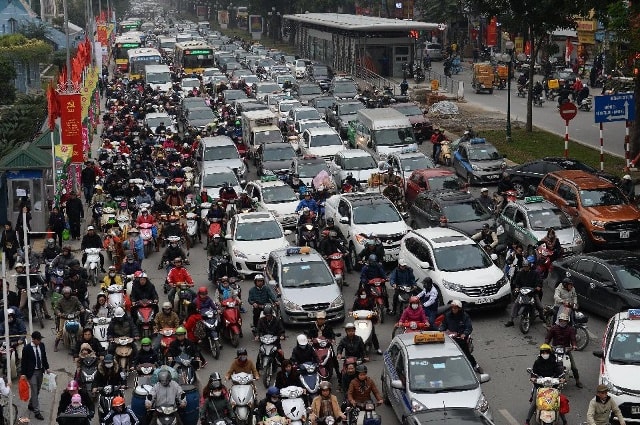Western newspapers talk about the painful traffic accident situation in Vietnam
Traffic accidents are currently a burning issue in Vietnam, claiming the lives of thousands of people each year. The foreign website Diplomat has mentioned this issue and proposed solutions in a recent article.
 |
| Current traffic situation in Vietnam (Photo: AFP) |
Traffic problems in Vietnam are always a concern for the people here. As for foreign tourists, they often take pictures of vehicles when they come to Vietnam, then share their experiences with friends and relatives. For pedestrians in Vietnam, crossing the street can become an "impossible mission".
Vietnam has made significant strides in its economic development. However, as the economy grows and the number of tourists to Vietnam increases, the road system and traffic regulation have not kept up with the explosion of vehicles.
Traffic congestion in Vietnam is caused by too many vehicles on the road, while the infrastructure is limited. The road system in Vietnam has not kept up with the increase in population and the number of vehicles, leading to congestion in some areas even during non-rush hours. In many areas, traffic congestion can lead to local congestion. Bicycle and motorbike drivers ride on the sidewalks, while many people do not hesitate to go the wrong way to avoid congestion. A common image in Vietnam is vehicles carrying more people than the prescribed number.
The high number of motorbikes on the road is partly due to the high price of cars in Vietnam. Those who want to own a car in Vietnam have to pay from 300 million VND, equivalent to 13,000 USD for a car, due to high production costs and special consumption tax. Therefore, nearly 95% of vehicles registered in Vietnam are motorbikes and there are about 9,000 new motorbikes on the road every day.
Heavy traffic has led to many traffic accidents, also known as a "mysterious epidemic" in Vietnam. While the Ministry of Public Security announced that the number of people killed in traffic accidents in Vietnam in 2010 was 11,000, the Ministry of Health said that, through data collected from the hospital system, the number of people killed in traffic accidents here was up to 15,464. According to Diplomat, the difference between the two figures above on the number of casualties due to traffic accidents may be to "reduce" the severity of the problem.
In recent years, the Vietnamese government has made efforts to improve road safety standards, such as requiring motorcyclists to wear helmets, in the hope of reducing the frequency and severity of accidents. It is estimated that about 60% of road traffic accidents in Vietnam occur between motorcyclists and pedestrians.
In 2001, the government enacted a law requiring motorcyclists to wear helmets on certain roads, such as national highways. In 2007, the government enacted a new law requiring all motorcyclists to wear helmets on all roads. However, this decision has caused a problem. According to Jonathan Passmore of the World Health Organization, up to 80% of helmets in Vietnam do not meet quality standards. Most helmets on sale in Vietnam are cheaply made and use poor quality plastic, which is not strong enough to protect motorcyclists.
In addition to helmet regulations, the Vietnamese government is also looking to address traffic congestion by building elevated highways, ring roads and overpasses to address the congestion problem.
According to experts, the above measures are often only effective in the short term. In the context of rapid urban population growth and many people moving to big cities to live, sooner or later Vietnam's authorities will again face difficulties in solving the congestion problem.
In addition to the need to improve the capacity of the authorities, the Diplomat website believes that the awareness of traffic participants also plays a very important role. In addition to issuing new and stronger regulations to reduce the number of serious traffic accidents, the awareness of traffic participants is considered a strategic issue for long-term solutions. It may take a generation to change the awareness of traffic participants, as well as for everyone to respect and comply with traffic regulations.
According to Dan Tri
| RELATED NEWS |
|---|



.jpg)


.jpg)

